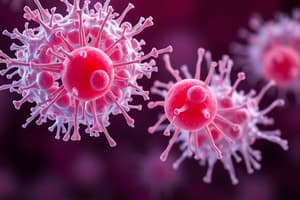Podcast
Questions and Answers
Which condition is characterized by hypersecretion of growth hormone in children?
Which condition is characterized by hypersecretion of growth hormone in children?
- Diabetes insipidus
- Gigantism (correct)
- Acromegaly
- SIADH
What is a common cause of diabetes insipidus?
What is a common cause of diabetes insipidus?
- Decreased urine output
- Tumor in the pituitary gland (correct)
- Dehydration
- Increased urine specific gravity
What is the main issue associated with acromegaly in adults?
What is the main issue associated with acromegaly in adults?
- Visual disturbances
- Decreased height
- Enlargement of internal organs (correct)
- Skin problems
What is the most reliable test to confirm diabetes?
What is the most reliable test to confirm diabetes?
Which medication is used to manage Syndrome of Inappropriate Antidiuretic Hormone Secretion (SIADH)?
Which medication is used to manage Syndrome of Inappropriate Antidiuretic Hormone Secretion (SIADH)?
What is the primary sign of fluid overload?
What is the primary sign of fluid overload?
Which metabolic parameter is monitored to check for dehydration or renal failure?
Which metabolic parameter is monitored to check for dehydration or renal failure?
In diabetic emergencies, what is the lifespan of red blood cells (RBCs) used in the glycosylated hemoglobin test?
In diabetic emergencies, what is the lifespan of red blood cells (RBCs) used in the glycosylated hemoglobin test?
What does the glycosylated hemoglobin test measure in relation to diabetes control?
What does the glycosylated hemoglobin test measure in relation to diabetes control?
What is a common symptom experienced by individuals with acromegaly?
What is a common symptom experienced by individuals with acromegaly?
Flashcards are hidden until you start studying
Study Notes
- Diabetic emergencies include Diabetic Ketoacidosis (DKA), Hyperosmolar Hyperglycemic Nonketotic Coma (HHNC), and Hypoglycemia (Insulin Shock).
- DKA is characterized by symptoms like blurred vision, weakness, acetone breath, Kussmaul respirations, and can lead to acidosis with plasma glucose levels exceeding 350 mg/dL.
- Treatment for DKA involves restoring fluid and electrolyte balance, reversing acidosis with NaHCO3, monitoring urine ketones, administering regular insulin, and preventing complications like hypokalemia and hypoglycemia.
- HHNC is similar to DKA but lacks Kussmaul respirations and acetone breath.
- Hypoglycemia can be caused by factors like omission of meals, overdose of insulin, strenuous exercise, and requires management with simple sugars orally or intravenously.
- Insulin therapy involves understanding different types of insulin such as Rapid-Acting, Regular, Intermediate Acting, Long Acting, and Pre-mixed Insulin to manage blood glucose levels effectively.
- Diabetic patients need to be monitored for signs and symptoms of diabetic complications like Glaucoma, Diabetic Stroke, Diabetic Nephropathy, and should maintain an ideal body weight, serum lipid profile, and engage in regular physical activity.
Studying That Suits You
Use AI to generate personalized quizzes and flashcards to suit your learning preferences.




